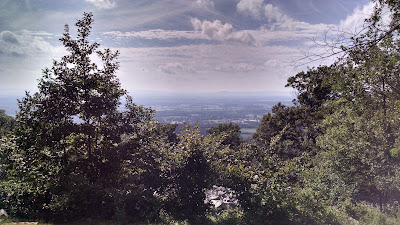 |
| Looking down into the valley where Boonsboro, Maryland is, from the George Washington Monument State Park. |
Having crossed the entire state using nothing but my feet, I can confirm that Maryland is mostly easier, at least compared to Georgia and much of Shenandoah. After all, the first three miles or or so is effectively flat, following the recreated C&O Canal towpath from Harpers Ferry to the point where the AT heads towards the ridge line of South Mountain. After the one truly large climb up past Weverton Cliffs, the rest of the hike in Maryland is effectively spent along the ridge of South Mountain. There are still the usual descents into gaps and climbs back up, but these climbs are often measured in tens, instead of hundreds (or thousands) of feet in elevation change.
 |
| Maryland Heights, across the Potomac River from Harper's Ferry. This picture is taken from the C&O Canal Towpath, which is maintained by the NPS from Washington, DC to Cumberland, MD. |
Many miles of the trail are wide with even footing, almost as if walking on a dirt/rock road. You pass through two state parks and a county park complete with power outlets, restrooms, and clean running water, one of which is close enough to get pizza delivered. Beyond that, there are many road crossings, often no more than a couple miles apart. A wilderness experience the hike through Maryland is not.
Unlike many states along the trail, Maryland is very stringent in allowing camping only in authorized sites. This includes six shelters (Ed Garvey, Crampton Gap, Rocky Run, Pine Knob, Ensign Cowall, Raven Rock), a primitive campground (Pogo Memorial), a primitive but maintained campground (Annapolis Rocks), and Dahlgren Backpacker Campground, a veritable backpacker resort with its running water, toilets, power outlets, and showers. These campgrounds and shelters are spaced out in a way that even slow hikers (like yours truly) can make it from one to another without having to go beyond their hiking comfort zone. Each of the shelters and campgrounds, save for Pogo Memorial and Ed Garvey, have either bear poles or bear cables, so you don't have to worry about throwing up your bear bag. This is good, because many of these areas don't have great trees for bear bagging.
The shelters range in quality from old and small but cozy to very new. Two (Rocky Run and Raven Rock) have beautiful hardwood floors that are a treat to sleep on, at least compared to some of the other shelter floors I've seen. I did not encounter any issues with the usual denizens of the shelters (mice), let alone other potential interlopers, be they raccoons or bears. Beyond that, I'll leave individual descriptions of the shelters for another volume of my shelter rankings.
 |
| Ed Garvey Shelter. A nice shelter, with the second level accessed by its own ladder and door in the back. The one drawback were nuts from a tall tree falling on the metal roof. |
 |
| Me at the end of my hike across Maryland. The mail box is used to hold the log book for this border, which is also the historic Mason-Dixon line dividing the North from the South. |

No comments :
Post a Comment